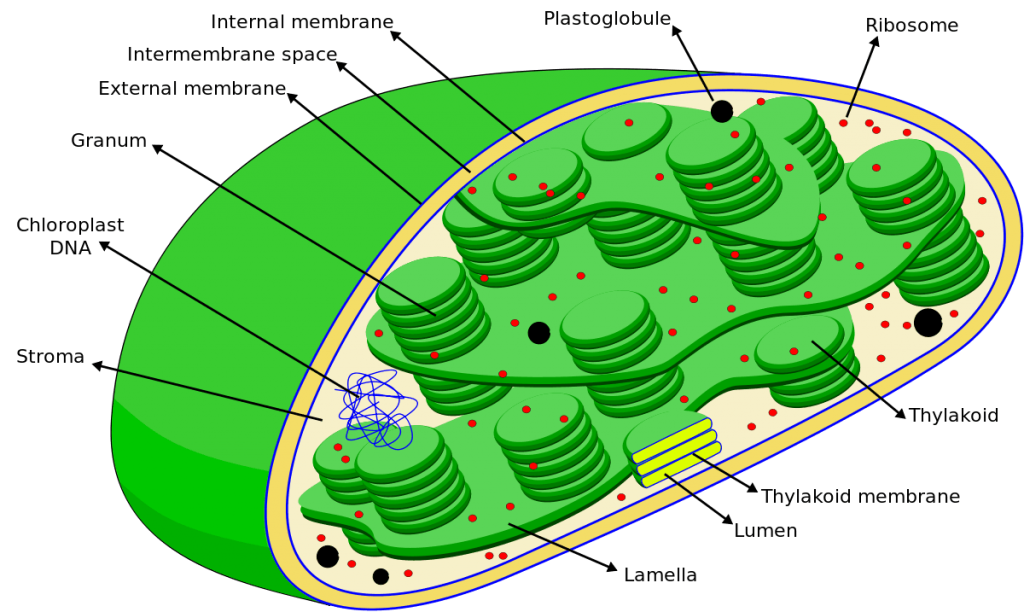Plants are producers that sustain life on this earth. Can you imagine a day when you are not using any material that is not ultimately resourced from plants? Cells of plants, also called plant cells, keep a plant alive and function. Among the different elements of a plant cell, some plastids are of crucial importance to plants. Even though plant and animal cells are both eukaryotic cells, you will not see plastids present in animal cells.
Plastids are double-membraned cellular structures (organelles) that can be divided into three types. These three types of plastids are Leucoplasts, Chromoplasts, and Chloroplasts. Storage and manufacture of food for the plants is their common function. What sets chloroplasts apart is that in their absence, photosynthesis would not be possible in plants. Let us learn more about what chloroplast is, what their functions and structures are.
Definition of Chloroplast
Chloroplasts are cell organelles of a plant that convert light energy from the sunlight into useful stable chemical energy. This conversion is made possible by a photosynthetic pigment called chlorophyll present in the Chloroplast of a plant cell. Chloroplast thus helps in the production of oxygen and other organic compounds from water.
What is Chloroplast?
The word Chloroplast is derived from Greek words ‘chloros’, which means green, and ‘plast’, which means ‘entity.’ Chloroplast is filled with a green-colored pigment called chlorophyll – a light-harvesting system. By nature, Chloroplasts are green-colored plastids. The presence of chlorophyll is responsible for eukaryotic plant cells being able to perform photosynthesis.
Chloroplasts are present and spread in the cytoplasm of a plant cell. The presence of chloroplast is one of the main factors distinguishing a plant cell from an animal cell. Chloroplasts also perform diverse activities related to the metabolism of a plant. It can synthesize different organic compounds such as fatty acids, membrane lipids, and more.
These organelles are called the guard cells and have their DNA, hereditary information present inside. Chloroplasts also possess the ability to reproduce without the need for a partner inside a plant cell, which means it reproduces independently.
Structure of Chloroplast
To learn more about Chloroplast, you first need to observe its structure. The structure of the chloroplast is essential to its functioning. Chloroplast is an oval-shaped semi-autonomous organelle that is present in the cytoplasms of plant cells.
- The thickness of a Chloroplast: 1–2 μm
- Diameter of a Chloroplast: 5–7 μm
Chloroplasts are double-membraned organelles, like we mentioned before. The membranes of Chloroplasts are of three types:
- Outer Membrane
- Inner Membrane
- Thylakoids System
The third membrane type of chloroplast can also be identified as an intermembrane space.
Let us talk briefly about the structure of chloroplast elements. Beginning with;
Thylakoids System/Membrane
Distinguished by the presence of thylakoids in the shape of closed disks. It is a third internal membrane in chloroplast apart from the inner and outer membrane.
Chlorophyll
Also known as the green photosynthetic pigment that absorbs solar power or light energy from nature. Chlorophyll is present in Chloroplasts on the surface of thylakoids.
Intermembrane Space
The space between the inner and outer membrane is called the intermembrane. The wideness of the intermembrane space is 10-20nm.
There are two distinct regions inside a chloroplast that you need to know about. These are;
Stroma
It is space inside the Thylakoid membrane, which appears as a matrix comprising dissolved amounts of enzymes, starch granules, and more inside.
Grana
Compact masses of thylakoids arranged together inside plants. Grana is the region of conversion of light energy into chemical energy inside plant cells.
Diagram of Chloroplast
This diagram is efficient to help you better grasp the working, functioning, and structure of the Chloroplast in a plant cell. You will notice the structure that we have mentioned. Moreover, envisioning how the chloroplast is essential to the existence of a plant as a basis of life on this earth can be understood with the help of this diagram.

Functions of Chloroplast
The primary function of chloroplasts in guard cells of plant leaves is to synthesize and store food. The chloroplast in a plant cell synthesis food through photosynthesis. Furthermore,
- Chloroplast converts inorganic matter, light energy, and water into relatively stable chemical energy, food (glucose) for the plant.
- The presence of chlorophyll in the Chloroplast makes photosynthesis possible. It traps the light energy from the sun and uses it to synthesize food for the sustain of plant life.
- The photolysis of water produces molecular oxygen (O2) and nicotinamide adenine dinucleotide phosphate NADPH, known for carrying electrons. This happens in the first stage of photosynthesis.
- With the help of photosynthesis, Chloroplasts produce adenosine triphosphate. It is also known as ATP, the intracellular energy transfer’s molecular unit of currency.
- It converts the NADPH electrons into carbon dioxide and, at last, carbohydrates. This process is known as carbon fixation. It occurs in the second stage of photosynthesis in chloroplasts and is called the Calvin cycle.

